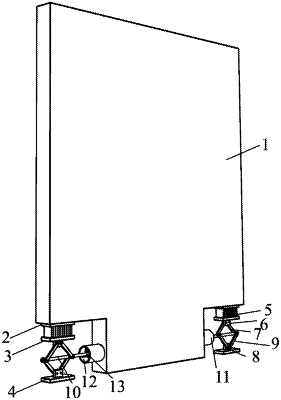| CPC E04H 9/0235 (2020.05) [E04B 1/98 (2013.01); E04H 9/021 (2013.01); E04H 9/0215 (2020.05); E04H 9/0237 (2020.05); E04H 9/027 (2013.01)] | 8 Claims |

|
1. A bottom corner damper with a displacement amplification function, wherein the bottom corner damper is fabricated with a precast shear wall with a rocking energy dissipation, and the bottom corner damper comprises upper connecting plates, middle connecting plates, lower connecting plates, bent steel plates, bolts, upper support arms, lower support arms, connectors, lead screws, cylinder barrels, viscous fluids, and propellers; wherein
the upper connecting plates, the lower connecting plates and the cylinder barrels are directly connected to the precast shear wall, and each of the upper connecting plates, the bent steel plates, and the middle connecting plates are connected by welding to form bending energy dissipation dampers; when the precast shear wall is damaged by shearing, viscous energy dissipation dampers dissipate a shearing force in a horizontal direction; during a bending and shearing damage, the bending energy dissipation dampers, the viscous energy dissipation dampers and displacement amplification and steering devices work together, the middle connecting plates, the lower support arms and the upper support arms are connected through the bolts, the upper support arms and the lower support arms are connected to the lead screws through the connectors to form the displacement amplification and steering devices, an acting force generated by an energy dissipation of the bending energy dissipation dampers is downwards transmitted through the middle connecting plates, the upper support arms connected to each of the middle connecting plates through the bolts and the lower support arms begin to stretch to two sides under the acting force, and the connectors are driven to move synchronously; the lead screws rotate at an accelerated rate under an action of the connectors, to amplify a displacement of an upper part, and convert the acting force in a vertical direction into a rotation in the horizontal direction; and the propellers are attached to end portions of the lead screws, the propellers extend into the cylinder barrels containing the viscous fluids to form the viscous energy dissipation dampers, and the lead screws drive the propellers to rotate in the viscous fluids to produce a viscous damping and dissipate a seismic energy.
|